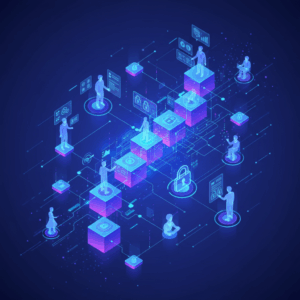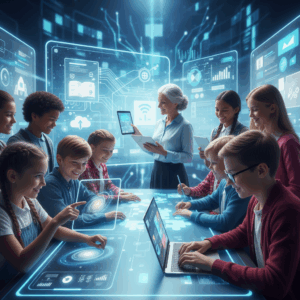Fundamentals of Generative AI
Generative AI is a branch of artificial intelligence focused on creating new content by learning patterns from vast amounts of data. It can produce images, text, music, and code, mimicking human creativity.
The rise of image and text generators marks a significant advancement in machines’ ability to perform creative tasks. These models move beyond recognition to produce original, contextually relevant outputs.
Understanding the fundamentals of generative AI involves exploring its definitions, scope, and the historical milestones that shaped its development into a powerful technology.
Definition and Scope of Generative AI
Generative AI refers to systems that create new, original content based on learning patterns from large datasets. This content includes diverse forms such as text, images, music, and more.
Unlike traditional AI, which focuses on classification or prediction, generative AI emphasizes content creation. Its scope covers creative applications and tasks previously thought to require human creativity.
These AI models operate by identifying and recombining data patterns, producing novel outputs that can appear innovative, though they are fundamentally based on existing information.
Historical Milestones in Generative AI Development
The roots of generative AI trace back to the 1960s with early conversational programs like ELIZA, which demonstrated basic machine simulation of human dialogue.
In 2014, Generative Adversarial Networks (GANs) revolutionized image generation by producing realistic visuals, sparking further advancements in generative methods.
Following GANs, variational autoencoders (VAEs) enabled novel image variations by capturing underlying data structures. Transformers, introduced in 2017, transformed natural language processing.
Impact of Transformers
Transformers allowed AI to understand context across long data sequences, leading to powerful language models like GPT that generate coherent and contextually relevant text.
Technological Advances Behind Image and Text Generation
The evolution of generative AI has been driven by significant technological advances, especially in neural networks and deep learning. These advances enable machines to create complex images and text from learned data.
Progress in generative models, including GANs, VAEs, and transformers, has unlocked new capabilities. Models have grown sophisticated enough to generate original content with high fidelity and contextual relevance.
Understanding these technologies helps explain how generative AI moved from simple pattern recognition to producing creative, often human-like outputs in various domains.
Role of Neural Networks and Deep Learning
Neural networks are the backbone of generative AI, mimicking human brain function to learn patterns from data. Deep learning, with multiple layers, enhances this ability by capturing complex relationships.
This approach allows AI to understand intricate details in images and text, empowering it to produce realistic and context-aware content. The depth of these networks is key to capturing nuanced features.
Deep learning frameworks scale effectively with large datasets, improving accuracy and creativity in outputs. Neural networks continually adapt, enabling the generation of increasingly sophisticated results.
Generative Models: GANs, VAEs, and Transformers
Generative Adversarial Networks (GANs) use two neural networks competing to create realistic images, leading to breakthroughs in image quality and realism since 2014.
Variational Autoencoders (VAEs) encode data into latent representations, then decode to new variations, offering flexibility in generating diverse, structured outputs beyond exact replication.
Transformers revolutionized AI by effectively processing sequences of data with attention mechanisms, enabling powerful language models and improved multimodal generative tasks.
Distinct Strengths of Each Model
GANs excel at creating high-quality images; VAEs are strong in learning data distributions for smooth variations; transformers handle context-rich text and image-text synthesis.
Evolution of Text-to-Image Systems
Early text-to-image models produced low-resolution images with limited detail. Their evolution through GAN-based approaches progressively enhanced coherence and visual fidelity from textual prompts.
The introduction of transformers enabled better understanding of text context, significantly improving the quality and relevance of generated images based on complex descriptions.
Today’s text-to-image systems like DALL-E generate highly detailed and creative visuals, illustrating how combining neural technologies produces seamless integration between language and imagery.
Modern Applications and Capabilities
The rise of generative AI has democratized creative tools, allowing users to produce art, text, and more with unprecedented ease. Public access to advanced models fuels innovation worldwide.
From detailed image creation to fluent text generation, modern applications showcase the versatility and sophistication of generative AI. These advances reshape creative workflows and user experiences.
Understanding key applications like DALL-E, Stable Diffusion, and the GPT series reveals how generative AI impacts art, communication, and productivity in today’s digital landscape.
DALL-E, Stable Diffusion, and Public Accessibility
DALL-E pioneered AI-driven image generation from text, producing detailed, creative visuals that reflect complex prompts. Its launch marked a significant leap in generative art accessibility.
Stable Diffusion and similar tools further expanded access by providing open-source or widely available models. These platforms empower users to create high-quality images without specialized skills.
Public accessibility enhances creativity across industries, enabling designers, educators, and hobbyists to leverage AI-generated visuals. This shift accelerates innovation and lowers barriers to creative expression.
GPT Series and Natural Language Generation
The GPT series exemplifies breakthroughs in natural language generation, producing coherent, context-aware text that can mimic human writing across diverse domains and styles.
Models like GPT-3 and ChatGPT support applications such as chatbots, content creation, and coding assistance, enhancing both productivity and user interaction through conversational AI.
These language models have wide-reaching implications, driving new opportunities in communication, education, and entertainment while raising important considerations about responsible use.
Implications and Future Perspectives
The rise of generative AI presents profound questions about creativity, authorship, and the ethics surrounding machine-generated content. These concerns are critical as AI blurs lines between human and artificial creation.
Understanding its impact involves exploring both the ethical dilemmas and the shifting nature of work, as generative AI offers new opportunities while posing challenges across industries and society.
Creativity, Authorship, and Ethical Considerations
Generative AI challenges traditional notions of creativity by producing content that mimics human originality through data recombination rather than genuine invention.
This raises complex questions about authorship and intellectual property as AI-generated works complicate ownership rights and creative credit attribution.
Ethical concerns include potential biases in generated outputs, misuse of technology, and the transparency of AI decision-making. Responsible development and regulation are vital to address these issues.
Ethics in AI Content Creation
Ensuring fair and unbiased AI systems requires ongoing scrutiny. Transparent processes and accountability frameworks are crucial to prevent harm and maintain trust.
Ethical guidelines should emphasize user consent, data privacy, and the prevention of harmful or misleading content generated by AI tools.
Opportunities and Challenges for Human Work
Generative AI offers exciting opportunities to enhance human creativity and productivity by automating routine tasks and inspiring new forms of artistic expression.
However, it also presents challenges such as job displacement and the need for workers to acquire new skills suited to collaborating with AI technologies.
Adaptation strategies including education, reskilling, and thoughtful integration of AI into the workplace will determine how humans and machines coexist productively in the future.






